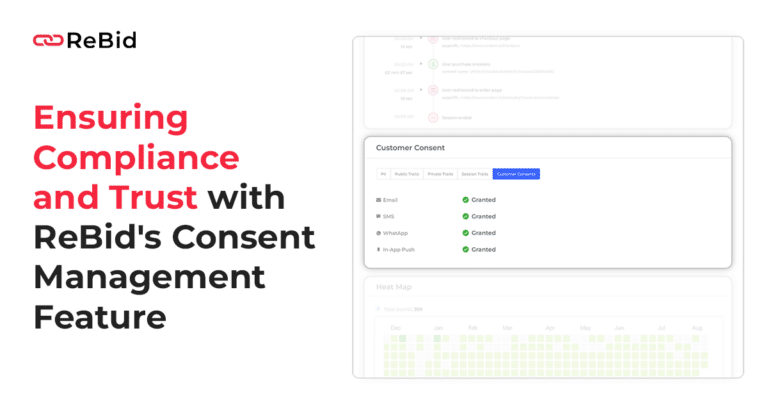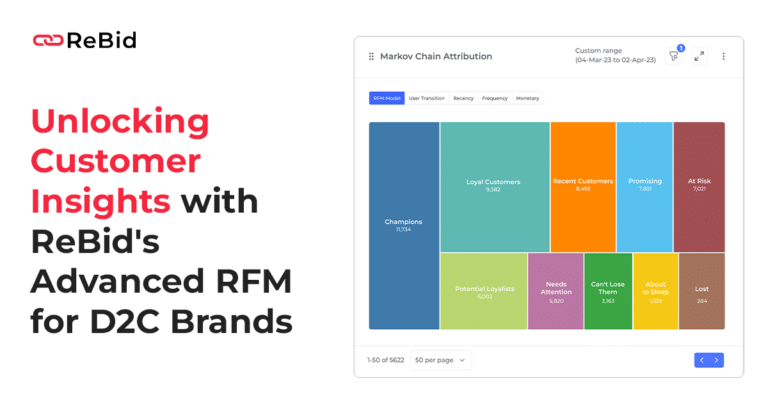Introduction
In today’s dynamic marketing landscape, a well-oiled martech stack is crucial for success. This comprehensive set of tools and platforms empowers you to plan, execute, measure, and refine your marketing efforts. But with the ever-evolving nature of technology, ensuring your martech stack remains optimized can feel like a constant battle.
Rebid, a leading provider of Advertisers’ Customer Data Platforms (CDPs), understands the challenges marketers face in the cookieless era. Our platform empowers you to unify customer data, personalize experiences, and optimize campaigns across various channels.
However, before diving into advanced solutions, it’s essential to master the fundamentals of martech stack optimization. This blog outlines a data-driven approach to ensure your technology ecosystem aligns with your marketing goals and delivers exceptional results.
1. Conduct a Martech Stack Audit
The first step is to gain a clear understanding of your current state. Utilize frameworks like the Marketing Technology Landscape or the Marketing Technology LUMAscape to map your existing tools and categorize them by function. This audit helps identify gaps, overlaps, and redundancies, allowing you to assess how each platform aligns with your strategy, objectives, and integration capabilities. Evaluate the cost-benefit analysis for each tool and prioritize them based on their impact on your marketing efforts.
2. Define Your Martech Stack Goals and KPIs
Without clear goals, measuring success becomes impossible. Define SMART (Specific, Measurable, Achievable, Relevant, and Time-bound) goals for your martech stack, aligning them with your overall marketing objectives. Translate these goals into quantifiable Key Performance Indicators (KPIs) like lead generation, conversion rate, and cost per lead. Establish baselines for your current performance and set realistic targets for improvement.
3. Implement a Data-Driven Feedback Loop
Data is the lifeblood of any optimization process. Establish a system to collect and analyze data from your martech tools, customer feedback, market research, and competitor analysis. Utilize data visualization and reporting tools to create insightful dashboards that track your performance against your KPIs and highlight trends, opportunities, and potential challenges. Leverage these insights to test, experiment, and refine your martech stack, ensuring continuous improvement and informed decision-making.
4. Streamline and Simplify
Complexity breeds inefficiency. Streamline your martech stack by eliminating unnecessary, outdated, or underperforming tools. Consolidate or integrate overlapping functionalities. Aim for a lean and agile stack that caters to your current and future needs, prioritizing marketing efficiency and effectiveness. Ensure scalability and adaptability to accommodate evolving customer expectations, market conditions, and business goals.
5. Train and Empower Your Team
Your team is the driving force behind your martech stack. Equip them with the necessary skills and knowledge to leverage these tools effectively. Foster a culture of learning and collaboration, encouraging feedback, suggestions, and best practices for continuous improvement. Recognize and reward your team’s achievements to maintain motivation and commitment.
6. Regularly Review and Update
Martech is a dynamic landscape. Conduct periodic audits and evaluations to ensure your stack remains relevant, reliable, and responsive to your evolving needs. Stay updated on the latest trends and innovations, exploring new tools and platforms that can enhance your marketing capabilities.
By implementing this data-driven approach, you can transform your martech stack from a collection of tools into a well-oiled machine, driving marketing efficiency, effectiveness, and ultimately, success.
Ready to take your martech stack to the next level? Explore how Rebid’s CDP can empower you to unify customer data, personalize experiences, and optimize campaigns across various channels. Start your free demo today: https://www.rebid.co/rebid-request-a-demo/
FAQs
1. What are the benefits of conducting a martech stack audit?
A martech stack audit helps you identify gaps, overlaps, and redundancies in your existing tools. This allows you to assess how each platform aligns with your strategy, objectives, and integration capabilities. You can also evaluate the cost-benefit analysis for each tool and prioritize them based on their impact on your marketing efforts.
2. Why is it important to define SMART goals and KPIs for your martech stack?
Defining SMART goals and KPIs for your martech stack provides a clear roadmap for success. It enables you to measure the effectiveness of your stack and track your progress toward achieving your overall marketing objectives. By establishing baselines and setting realistic targets, you can make data-driven decisions and optimize your stack for continuous improvement.
3. How can companies ensure their martech stack remains adaptable and scalable?
To ensure your martech stack remains adaptable and scalable, it’s crucial to regularly review and update your tools. Stay informed about the latest trends and innovations in the marketing technology landscape. Explore new tools and platforms that can address evolving customer expectations, market conditions, and your business goals. Regularly evaluating your stack allows you to identify opportunities to streamline, consolidate, or integrate functionalities, fostering a lean and agile environment that supports your marketing efforts effectively.





